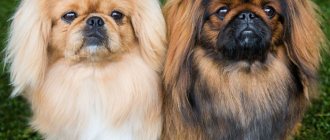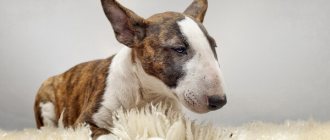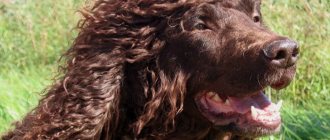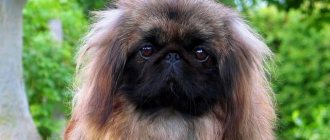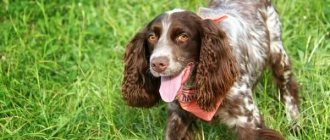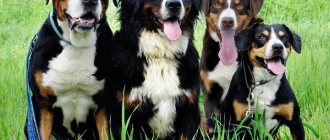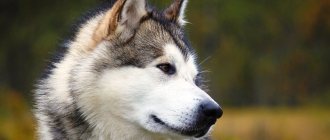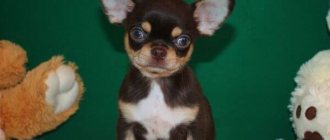The Pekingese is a popular toy dog. It belongs to the ancient breeds, bred in China more than 2 thousand years ago. Previously, Pekingese were called “sacred dogs of the house of Chinese emperors.” When other countries learned about them, they quickly spread throughout the world. Now everyone will recognize this dwarf dog with long hair and a flattened muzzle. She has a sweet, original appearance and a complex character. Thanks to their small size, Pekingese are easy to keep in a city apartment. But before you get this breed, you need to study its characteristics, pros and cons, and reviews from owners. A photo of Pekingese shows the characteristic appearance features:
- Interesting Facts
- Breed standard
- Education and training
- Pekingese coat care
Origin story
The history of the Pekingese dates back to Ancient China, where these dogs were bred more than two thousand years ago. There, Pekingese were considered a gift from Buddha and guardian spirits of the ruling dynasty, and therefore only members of the imperial family could keep them.
Taking Pekingese out of the territory of the Celestial Empire was considered a terrible crime, and the one who kidnapped the dog from the palace faced the death penalty.
But sometimes puppies, as a sign of special favor, were presented to people who had rendered special services to the imperial dynasty, and sometimes even foreigners were among them.
The Pekingese ended up in Europe after Beijing was captured by the British in 1860. The soldiers, having discovered five living dogs in the palace chambers, sent them as a gift to Queen Victoria.
In Britain, for some time they tried to use Pekingese not only as salon dogs and companion dogs, but also for hunting, guarding and herding sheep..
English breeders of the second half of the 19th century wanted to improve the original breed and make it more universal, however, all these attempts were unsuccessful, and the breed began to acquire features that were unusual for it.
As a result, it was decided to return to the original type, thanks to which modern Pekingese look almost the same as their ancestors from Ancient China.
Interesting Facts
- The white color of the Pekingese was not popular in their historical homeland because the white color in China is considered a symbol of death.
- The Pekingese first arrived in countries such as Germany, Holland and the USA in 1900.
- DNA analysis has shown that Pekingese are a breed related to pugs, papillons and even chihuahuas.
- Pekingese are considered one of the longest-living dogs, with many living 18-20 years.
- These dogs have become the heroes of many cartoons and feature films.
- Pekingese Puggy from the USA is considered the dog with the longest tongue, which reaches a length of 11.43 cm.
- The Pekingese almost became the most expensive dog in the world: 32 thousand pounds was offered by an American millionaire to Englishwoman Clarissa Ashton Cross for her dog, but she refused to sell her pet.
Education and training
The breed is quite difficult to train due to its breed characteristics, in particular stubbornness and proud temperament. It is better to punish the Pekingese not with a loud voice or physical force, but by ignoring it. This method works best on the little “king”. It is advisable to start the learning process as early as possible - from 2 to 2.5 months.
Golden rules in training a Pekingese:
- Follow the regime and regularity of training.
- Do not hurry.
- Praise for success.
- Always achieve your goal.
- The main helpers are affection and perseverance.
- Be an authority and a good example.
- Combine learning with play.
- Do not be nervous.
- Exercise only with a completely healthy pet.
Description of the breed
Pekingese are small, short, squat dogs with a proud posture, thick long hair and a short muzzle..
The head is quite large, its width slightly exceeds its length.
The ears are well furred and not too long. The eyes are round, widely spaced, dark and protruding.
Snacking is typical for this breed.
The body is rectangular in format, the paws are short with a moderately wide set.
The chest is deep, extending below the elbow joints.
The back is straight and moderately wide, the withers are weakly defined.
The tail is of medium length, set high and heavily feathered. It flies abandoned over its back and looks like a fan.
The coat is thick, elongated, forming a mane on the neck and shoulders, as well as feathering on the tail, ears and paws.
Any color other than white is allowed if it is associated with the albinism gene.
Description of the appearance of Pekingese
Representatives of this breed are small in size, regal in posture and have an unusual appearance. They are easy to recognize simply by the description of their exterior features:
- small strong body;
- short legs;
- a very fluffy tail lying on the back;
- ears tilted forward, with feathering;
- the muzzle is short, flattened, there is a fold on the nose;
- big round eyes.
Breed standard
The first breed standard was created at the end of the 19th century. Its modified version, adopted in 2004, is now in effect. According to it, the height of an adult Pekingese at the withers should not be more than 25 cm, weight - up to 5.5 kg. Unlike representatives of other breeds, females weigh more than males. Photos complement the description of the appearance:
Appearance
Appearance
Head
The head is large and wide in relation to the body, the muzzle is short. The forehead is flat, the transition to the nose is pronounced, almost at a right angle. A small fold of skin runs from the bridge of the nose to the cheeks. She shouldn't close her eyes. The nose is black, flattened, the nostrils are large. The lower jaw protrudes. The lips are black and thin. The teeth are small, without spaces, and meet in a tight bite. The ears are heart-shaped. Covered with fluffy hair, they hang down, fitting tightly to the skull. The tips should not fall below the nose. The Pekingese's eyes are round and always dark. Large in relation to the muzzle, widely spaced. May be slightly convex, but not protruding. The look is smart, a little surprised. The eyelids are black and do not droop. The pictures show the structural features of the Pekingese head:
Head
Muzzle
Body type
The body is rectangular, compact, the back is straight. The chest is wide, the ribs are convex, and the waist is clearly defined. The neck is short, powerful, completely hidden by fluffy hair. The tail is set high, lies on the back, and is often tilted to the side.
Limbs
Limbs are parallel, of medium length. The front ones are thick, set wider than the rear ones, and more powerful. Elbows pressed to the body. The hock joints are clearly defined and located low. Pekingese paws are large and flat. They move slowly, waddle, but confidently. They don't like to run, but they are resilient when necessary. The body features of the Pekingese are visible in the photographs:
Body type
Body type
Features of Pekingese wool
The coat is straight, hard, medium length. Forms a fluffy collar and feathers on the paws. The longest hair is on the ears and tail. The undercoat is soft and fluffy, so the coat forms a halo around the body.
Colors
Now the standard allows several colors of the Pekingese:
- the most common color is from golden to dark red, black tan is possible;
- fawn, milky or cream, sometimes with a black muzzle;
- black Pekingese are popular;
- black and tan and black with white markings.
A dog of any color may have a white spot on its forehead. In ancient China, such dogs were believed to bring happiness. The standard does not allow colors such as gray, red, spotted. Pure white Pekingese are also not recognized, but are valued by fanciers. Photos showing the characteristics of wool and the variety of colors:
Summer on the grass
Black color
Varieties
There are no such varieties as the Royal, Imperial or Chinese Pekingese. But representatives of the breed are divided into two groups based on coat type. The standard and most common are the long-haired Pekingese. There is also a smooth-haired variety. Most often, black and white Pekingese have short hair. They have no feathering, ears are not fluffy and there is no thick undercoat. Such dogs, like shorn long-haired dogs, are not allowed to exhibit. There is also a dwarf variety of Pekingese. This is not a separate breed, but a subspecies not recognized by the standard. The weight of mini dogs is no more than 2.5 kg; they are not allowed for breeding, as they cannot bear offspring. Such dogs appear with standard parents and are popular. Dwarf varieties existed in ancient times. The Chinese wore them in the sleeves of their kimono and called them sleeve dogs.
Character traits
Pekingese are balanced and calm pets with a somewhat arrogant and independent disposition. Despite their small stature, they are brave and fearless: they do not hesitate to accept a challenge and engage in battle with larger opponents.
These dogs are very smart and quick-witted, they are easy to train, but they can show stubbornness and even disobedience if it seems to them that the owner, forcing them to follow commands, is trying to manipulate them.
High ambition and the habit of considering themselves the center of the universe make Pekingese dogs demand adoration and even reverence from their owners.
The Pekingese is not a dog that will tolerate rude or inappropriate treatment.
However, the independent nature of these dogs and their self-sufficiency allow owners to safely leave home, leaving the pet alone. Pekingese, in the absence of the owner, will not damage the furniture or tear off wallpaper from the walls, but will find something more harmless to do.
Expert opinion
Kozhevin Semyon Kirillovich
Expert dog handler.
“Pekingese have a proud and independent disposition. These dogs, despite their small stature, carry themselves majestically and consider themselves the center of the universe. At the same time, Pekingese are calm, balanced and not mischievous, which makes them suitable as companions for working single people. But it’s better not to have Pekingese in a house with kids, as these dogs can’t stand being annoyed or teased.”
Place in the pack
The nature of a dog helps the owner feel like a family. The genetic “memory of ancestors” forces wild and domestic dogs to strive to take the place of the leader, protecting the members of the pack and helping them survive.
By default, the owner occupies this warm place, but the dog strives to test the person from time to time. Is he worthy of such an honor?
The passion to challenge and challenge leadership appears in a pet at the age of 4-6 months. Dogs demonstrate rivalry by refusing to follow commands and by insisting on climbing onto the sofa or bed, even though it is forbidden. Less often, growling when wiping their paws after a walk or at the owner approaching a full bowl of food. A few bite slightly.
It is wrong to be afraid of this, to be afraid in the future to regularly encounter the insolence and aggressiveness of a pet.
A dog does not rebel if it perceives its owner as a calm, self-confident person, fascinated by it, caring, guiding with leadership pressure.
It is advisable to raise a growing puppy with the whole family. Pets should practice basic commands with the dog. In the little mind of the puppy, the picture will form that in this pack he is almost an equal. But he must be smart, and also - she already has the best leader in the world.
Advantages and disadvantages
pros:
- Calm and balanced.
- Beautiful.
- Smart and quick-witted.
- Well trained.
- Not prone to mischief.
- Even very busy people can keep Pekingese, as these dogs are self-sufficient and do not need constant communication with their owner.
- Loyal, although their love still needs to be earned.
- Their small size makes these dogs suitable for small apartments.
Minuses:
- Arrogant and independent disposition.
- They are so fearless that they can get into a fight with a stronger and larger opponent.
- Not suitable as pets for families with small children.
- They are ambitious and have their own worldview.
- They can be stubborn and self-willed.
- They are predisposed to a number of breed-specific ailments.
- They need daily coat care.
Pekingese clothes
The smooth-haired Pekingese needs special clothing all year round:
- In winter, this is a warm overall made of soft fabric with a synthetic padding lining.
- In wet weather, you can wear special waterproof overalls with a hood to protect your ears.
- In summer, you can protect your smooth coat from debris using a special mesh overall.
- Some owners also buy shoes for their pets, but rare dogs agree to wear them.
Is he good with children and does he get along with other pets?
Pekingese are good with school-aged children, who treat them with respect and gentleness.
But these dogs may not like very young children because of their noisiness, as well as the fact that small children are often too intrusive.
In this case, the Pekingese is unlikely to tolerate such treatment: at a minimum, he will snap at the child.
Often, communication between children and dogs of this breed ends in bites, albeit mild ones, as well as mutual insults.
Pekingese are able to get along with other pets, including cats, but only if they do not try to annoy or dominate them.
Pekingese varieties
Due to the rich palette of colors, the appearance of Pekingese can vary greatly, but there are no official subspecies in the breed. Fans and ordinary people distinguish the following types of breed:
- Dwarf Pekingese, which is called hand, sleeve, pocket or mini. Dog handlers do not single out such dogs, because they are born from normal-sized parents. A reduced body is only a genetic defect that can only be noticed by the age of 8 months. Such pets should not be allowed to be bred.
- The Imperial or Royal Pekingese received the prefix to the name of the breed thanks to a marketing move by breeders. This title is added to pets to give them respectability and price.
How to properly care
The Pekingese's coat should be brushed daily. Wash your pet 4-5 times a year, and it is recommended to use special shampoos for long-haired dogs.
Due to their short legs and lush coat, these dogs get very dirty during walks, therefore, it is advisable to take them out for walks in protective overalls.
You can also trim your dog's hair to make caring for it easier. But this can only be done if the Pekingese is not exhibited.
The pet's eyes and ears should be examined every day, and if dirt appears, cleaned with special drops or lotions applied to a cotton pad. The ear canal is cleaned with cotton swabs.
Teeth should also be brushed as needed and examined daily, this is especially important when changing baby teeth to permanent ones..
To clean the teeth, you can use a brush and dog toothpaste, or simply let your pet chew on special treats or toys purchased at a veterinary pharmacy or pet store.
It is recommended to trim the claws with a nail clipper as they grow..
Caring for Pekingese dogs
This is a dog for keeping at home. But you need to make sure it doesn't get too hot. They cannot cool themselves like other dogs and their fur is thick and long. Therefore, it is recommended to install an air conditioner at home to maintain a normal temperature. Pekingese love to play when walking, but it is better not to let them off the leash. The pet can run away, loves to pester large dogs, and if there is a body of water nearby, it will definitely climb into it. Apart from grooming, this dog requires standard hygiene procedures:
- wipe your eyes once a week;
- check the ears every few days; their fluffy fur creates a favorable environment for the growth of bacteria;
- Brush your teeth 2-3 times a week;
- Check the nose fold regularly and, if necessary, dry it with a soft cloth or treat it with veterinary lotion;
- trim nails when they become visible from under the fur;
- Sometimes the hair on the paws and above the eyes needs to be trimmed.
This dog needs to be bathed as rarely as possible. Veterinarians recommend doing this 2-3 times a year. The rest of the time, use dry shampoo. Paws or belly that are dirty after a walk can be washed separately under running water.
Pekingese coat care
It is difficult to care for the Pekingese's coat; it needs to be brushed daily. The procedure takes 10-15 minutes, but if you do not do it regularly, the hair will fall off and tangles will form. When brushing your Pekingese, you can use a long-toothed comb or a stiff-bristled brush. The wool must first be moistened with water from a spray bottle or conditioner, then the hairs will not break. The fur that gets tangled the most is on the paws, tail, and ears. It is combed out with a metal comb. It is better to trim the hair between the fingers and above the eyes so that they do not interfere. Some owners give their pet a haircut. This is especially convenient in the summer, since Pekingese do not tolerate heat well. A pet with a haircut will suffer less, but it will no longer be allowed into the exhibition. You can trim your Pekingese at home or at a groomer. Video about combing and cutting a Pekingese:
What to feed Pekingese
Pekingese are picky eaters, prone to allergies and excess weight. Due to improper diet, their hair may fall out. Therefore, it is important to carefully choose what to feed your dog. The diet should contain sufficient amounts of protein and fat. Nutrients in industrial food are balanced. But Pekingese are picky, and they quickly get bored with monotonous dry food. This problem can be solved by adding canned food from the same manufacturer. You need to choose premium and super-premium food that does not contain wheat or corn. This diet is convenient for the owner and provides the pet with all the necessary microelements.
Using the recommendations on the packaging, it is easy to determine how much food your dog needs per day. It is usually recommended to give 60-100 g. When feeding natural food, the main place in the diet should be taken by lean meat. It is mixed with rice, buckwheat or oatmeal. You can also give offal, sea fish, eggs, cottage cheese, and fermented milk products. Fresh or boiled vegetables and fruits are healthy. You cannot give Pekingese food from your table, sausages, legumes, spicy and fatty foods, baked goods, and sweets. These dogs are prone to overeating, so it's best to ask your veterinarian how much food they need per day. You should not indulge your pets or give them pieces, as they quickly gain weight.
Health and illness
When favorable conditions are created, Pekingese live 13-15 years. But these dogs are in poor health. They are prone to some congenital and acquired diseases:
- pathologies of joints and intervertebral discs;
- entropion, cataracts, dry eye syndrome, retinal atrophy and other eye diseases;
- folded dermatitis;
- hair loss;
- mitral valve pathology.
Breathing problems are especially common. This is a brachycephalic breed, so it is difficult for the dog to even take a breath. For this reason, Pekingese often snore, grunt, and make other sounds. It is also difficult for them to tolerate heat and run a lot. It is recommended to take him out for walks in a harness, as the collar further impairs breathing.
Sometimes Pekingese owners are faced with such a problem that their pet's eye has fallen out. This pathology is called eyeball luxation. Only found in flat-faced dogs. Due to their special structure, the eyeballs fall out during injury or severe stress. Even careless handling of your pet can lead to this. When an eye falls out, the owners get scared. But if you immediately contact a veterinarian, your pet’s vision will be preserved.
The health of the Pikinese requires special attention. They are weak and painful, prone to allergies and digestive disorders. Such dogs cannot bear and give birth to puppies, therefore they are not allowed for exhibitions and breeding. To protect your pet from infections, you need to give him all the necessary vaccinations on time. It is recommended to give anthelmintic drugs once every three months, and to treat for parasites every month in the warm season. Regular examinations by a veterinarian will help to identify health problems early and avoid complications. The video will show what you need to be prepared for when you get a dog of this breed:
How long do they live? Health and major diseases
The average life expectancy of modern Pekingese is 12-15 years.
However, if the dog comes from healthy lines and is properly maintained, it has a chance of living to 18-20 years of age.
Pekingese are a fairly healthy breed: they rarely get sick, but can be predisposed to a number of ailments associated with their elongated format and the specific structure of the head and muzzle:
- Progressive retinal atrophy.
- Cataract.
- Keratitis.
- Turn of the century.
- Dislocation of the eyeball.
- Cardiovascular diseases, including congenital or acquired heart and valve defects.
- Deformation of intervertebral discs.
- Respiratory diseases.
- Perianal adenoma (only in males).
Nutritional features - what is best to feed? How many times a day?
You can feed the Pekingese with both natural food and ready-made high-quality food of premium class and higher. It is very important that the dog’s diet is complete, but not excessive, since overfeeding has a bad effect on the health of representatives of this breed.
When feeding naturally, the Pekingese should receive meat, offal, as well as raw or boiled vegetables and dairy products . Porridge should also be present in the diet, but they should not form its basis.
You cannot mix natural products with ready-made food or alternate them with it.
At first, it is recommended to feed the puppy as many times a day as in the breeder’s home, later the number of feedings is reduced.
Adult Pekingese receive food 2 times a day.
The best dry food:
- Acana Heritage Adult Small Breed
- Bosch Mini Adult Lamb & Rice
- Brit Premium Adult S
- Dailydog Adult Mini Breed lamb and rice
- Eukanuba Adult Dry Dog Food For Small Breed Chicken
- Farmina Cibau Sensitive Fish Mini
- Hill's Science Plan Canine Adult Small & Miniature Lamb with Rice
- Grandorf 4 Meat & Brown Rice Mini
- Purina Pro Plan Small & Mini Adult сanine Sensitive Skin Salmon and rice dry
- Royal Canin Mini Adult
- Wellness Dog CORE Small Breed Original
Sample menu for the week
| Day of the week | Morning feeding | Evening feeding |
| Monday | Kefir (yogurt) + cottage cheese | Meat + stewed pumpkin + buckwheat porridge + flaxseed (olive oil) |
| Tuesday | Natural yogurt + cottage cheese + grated apple | Boiled liver + boiled carrots + vegetable oil |
| Wednesday | Ryazhenka (kefir)+cottage cheese | Meat + stewed zucchini + linseed (olive) oil |
| Thursday | Natural yogurt + cottage cheese + mashed banana | Boiled beef heart + boiled pumpkin + rice porridge |
| Friday | Kefir + cottage cheese + raw grated carrots | Boiled boneless fish + boiled carrots or zucchini + vegetable oil |
| Saturday | Natural yogurt + cottage cheese + grated apple | Meat + baked pumpkin + oatmeal + olive oil |
| Sunday | Kefir + cottage cheese + mashed banana | Boiled liver + boiled carrots + buckwheat porridge |
How to choose? Boy or girl?
Even if you are purchasing a pet and not a show-class puppy, you should buy a Pekingese from a nursery or a breeder. At the same time, when searching for a future pet, it is necessary to pay attention not only to the titles and pedigree of its ancestors, but also to whether this line is healthy.
In the litter, you need to choose a puppy that is moderately energetic and active, who does not show aggression towards other dogs in the kennel or towards people.
The baby must be completely healthy and look standard. He should not have too long or, conversely, short hair, and his color, if white, should not be associated with albinism.
IMPORTANT!
Experts recommend purchasing a female dog if you need a pet for your family and a male dog, or if you need a dog to participate in exhibitions, since male dogs usually look more impressive in the ring due to their richer mane.
However, it is not superfluous to take into account the fact that males are distinguished by a more stubborn and willful disposition, while females are softer and friendlier in character, they are more obedient and easier to train.
Puppies
If you want to raise a dog “from scratch,” then you should buy not an adult pet, but a puppy. The choice is quite difficult, since puppies require more careful care, time and attention. It is also necessary to have some experience or knowledge to acquire a healthy pet of the desired breed.
Choosing a puppy
If you want to buy a real Pekingese, do not look for it at the poultry market or in the transition. Find out about a kennel club that can provide you with information about breeders.
When you go to a nursery, don't expect to leave with a purchase. A good dog breeder will first ask you about your living conditions, the reasons for your decision to get a dog, and will also be able to give invaluable recommendations. Observe the puppies, their games and behavior. The owner will be able to tell you about the individual characteristics of each baby. If the puppies are still too small, the breeder may ask you to wait until they have had their first vaccinations.
Puppies should smell nice, be clean, and have no discharge from their shiny eyes. The tail is usually perky and curled upward. Check the brand or chip, as well as the puppy card.
Before you bring a puppy into your home, make sure that you will be able to devote enough time to him.
The pet must get used to the new habitat and rules. You should not buy a Pekingese before a big holiday, since in the hustle and bustle you will not be able to devote time to timely walking, which is so important for a small puppy.
Puppies need frequent feeding, which reaches 6 times a day and gradually the number of meals is reduced.
Pekingese
Nurseries in Russia and the CIS
In Russia, Pekingese can be purchased at one of the many nurseries:
- “Divine Flower” (Moscow)
- “From the Jasmine Palace” (Moscow)
- "Magri-Olifer" (Moscow)
- "San Ray" (Moscow)
- "Baltivskiy Kapriz" (St. Petersburg)
- "Elitlain" (St. Petersburg)
- "Ganko Saffi" (St. Petersburg)
- "Mirka" (St. Petersburg)
- "White Sun" (Chelyabinsk)
- "Image Dream" (Cheboksary)
- "Rumar Caprice" (Belgorod)
- "Savelina" (Novosibirsk)
- "Siberian Crown" (Krasnoyarsk)
In Ukraine, a dog of this breed can be bought in these nurseries:
- "Diantes Sanches" (Kharkov)
- “Julian Angel” (Vyshgorod)
- “Roman s Nadezhdoy” (Kharkov)
- “Waltz of the Flowers” (Dnepropetrovsk)
- "Eastern Dream" (Lutsk)
In Belarus, Pekingese can be bought at the Luchik Solntsa nursery, which is located in Minsk.
Contact details for nurseries can be found on their websites and social media pages.
Owner reviews
“Our Pekingese is a threat to the entire yard, he can attack a large dog, but he is affectionate and friendly towards people. He treats children well, but only when they pet him or play with him, but he does not tolerate insults - he growls and can bite, although more for show. Our dog has a good immune system, so he rarely gets sick, except for a slight inflammation of his eyes that he had once. There are no problems with nutrition, except for the fact that he is a terrible beggar: he loves to beg for goodies, standing on his hind legs, and he eats more willingly from his hands than from a bowl.”
“We bought our pet with documents, but the dog still turned out to be quite problematic. She has already had conjunctivitis three times, and due to the peculiarities of her bite, she has to grind her food, since she cannot chew large pieces. She is generally picky when it comes to food: she only eats what she wants. In addition, her fur has to be combed every day, and if this is not done on time, it becomes crumpled and tangled.”
“By the time we got our Pekingese dog, there was already a cat living in the house. The dog turned out to be very smart and obedient, did not annoy the cat, and did not pay attention to him at all. She didn’t spoil things, used the litter box to go to the toilet, ate natural food, and, in general, didn’t cause any trouble. But, unfortunately, we did not foresee that it would not be the dog who would be jealous, but the cat, who had already lived in the house for many years and whom we could not part with, and therefore we had to give our Dolly to our relatives.”
“Our dog was given to us by friends: they gave birth to a Pekingese puppy and one puppy remained unsold, so he ended up in our house. From the very beginning we liked the dog and we all loved her and tried to take good care of her. True, we have small problems with feeding: the pet will not eat everything, and she also loves bagels, although it is probably wrong to give them to her. Now that the dog is no longer young, she has health problems. However, despite this, she is still for us the best dog in the world, with whom we will never part.”
“Our Pekingese loves to walk outside and loves to roll in the snow. In mud or slush, you have to put on overalls on him, since he has a habit of stomping right through puddles. He treats children normally, or rather, indifferently, but only when they themselves do not touch him. Caring for him is not too difficult, except for the fact that he has to comb his coat every day and take him to a grooming salon for a haircut in the spring. By nature, the dog is quite temperamental and a little jealous, he loves when people fuss with him and pay attention to him, but at the same time he can be affectionate and even playful, but this, of course, depends on his mood.”
Description: character and temperament
The phlegmatic Pekingese is a breed of royal blood, because in its historical homeland it could only be a member of the royal family. Genetic memory has preserved the proud posture, leisurely movements and majestic, wise look of the little emperor. His manners radiate with the consciousness of his own exclusivity and arrogant calm. He is confident in his irresistibility and is extremely proud of himself.
When properly trained, the Pekingese is gentle, obedient and flexible with his family, and when communicating with strangers he is courageous and fearless, so it is important to wean him from rushing at guests and dogs while walking. The monarch is easily offended, often capricious in food and willful. The dog may not like the fact that you decided to play with him while resting or take him for a walk at an inconvenient time for the dog.
In order not to raise an uncontrollable “king”-manipulator, you need to sharply suppress any manifestations of aggression, both dominant and cowardly. This is a manifestation of distrust of the leader and an attempt to take on his responsibilities. Try to become a leader for your pet, for whom he will feel not fear, but respect and trust. Only in this case will it be possible to win the favor of the proud creature. Treat your baby with respect, do not leave him alone, and pay attention to playing together. The Pekingese will definitely reciprocate. His friendship is characterized by incredible sincere affection.
The Pekingese's behavior is most often lazy and relaxed. He does not accept vanity and often becomes simply a bastion of peace and slowness. Do not shout at the animal or rush it while walking or at home. These are just natural personality traits of the Pekingese that you need to put up with. Most individuals are moderately playful and active, loving short games in the fresh air.
